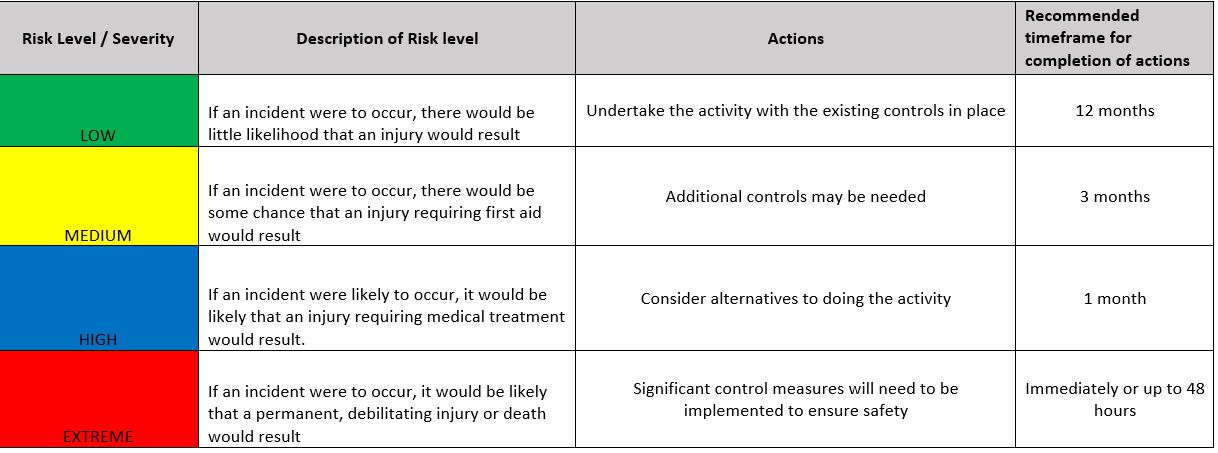Title Page
-
Site conducted
-
Campus
-
Zone(s) Inspected
-
Block/Level
-
Date
-
Prepared By
-
Location
LOW RISK OFFICE CHECKLIST
1. Housekeeping
-
• Aisles and walkways clear and free from obstructions / trip hazards
-
• No loose items / rubbish build up stored in communal areas
2. First Aid
-
• Cabinet/kit available in area/near
-
• Easily accessible
3. Stairs/Walkways
-
• Clearly marked
-
• Sound condition
4. Floor Coverings
-
• Sound condition
-
• If temporary, firmly fixed / no trip hazards
5. Fire/Exits
-
• Exits unlocked and easily opened from inside
-
• Clear from obstructions
-
• Clearly sign posted and exits signs working
-
• Fire extinguisher in place and tested/tagged within last 6 months
-
• Evacuation maps displayed and accurate
6. Lighting
-
• All operational and no flickering lights
-
• Sufficient lighting in work areas
7. Desks/Chairs
-
• Clear of unnecessary clutter, trip hazards, damage and sharp edges
-
• Chairs in sound condition
8. Kitchen
-
• Sink / grill / exhaust fan / fridge / general area clean and hygienic
9. Cupboards/Shelves/Storage
-
• Suitable/practical structure
-
• Stored material secure and stable
-
• Heavy items / Stored material not stored above shoulder height
10. Waste
-
• Waste bins are adequate/distinctive
11. Electrical
-
• Plugs/power points not damaged
-
• Leads cords not worn/frayed and in good condition, secured safely
-
• Power boards used correctly / no double adapters in use
HIGH RISK AREAS CHECKLIST
-
Audit to conduct
Chemicals
-
Chemical/fume cupboard secure
-
Containers clearly labelled
-
Current SDS in file
-
Chemicals stored appropriately (refer to SDS sheet to check)
-
Eye wash station provided / tested or eye wash kit available in first aid kit
-
Spill kit available
-
Chemical hazard signage visible
Signs
-
Evacuation Maps displayed and current
-
No food/drink
-
No working without supervision/permission
-
Wear appropriate PPE
-
Correct footwear in workshops
-
Use of ear muffs/plugs
Grounds
-
Free from litter/debris
-
Steps/pavers/access ways in good order
-
Adequate rubbish bins
-
Outside seating in good order
-
Sufficient lighting/security
-
Clear of obstacles – reticulation/holes
-
Exits from buildings clear
Hazards
Hazard Identification
Section 1 – Major Hazard Recording
-
Conditions or practices that pose a real and current threat to the safety of staff and students. These hazards should be monitored by the appointed Safety & Health Representatives and reported to the Safety & Injury Management Team and your Campus Safety Committee. Please identify the Hazard Type using the table provided above.
Hazard
-
ID No.
-
Hazard Type
- Manual Handling
- Falls
- Electrical
- Mechanical
- Biological
- Hazardous Substances
- Thermal
- Noise
- Psychological Stress
- Radiation
- Physical
- Ergonomic
- Safety
-
Severity
-
Room/Location
-
Unsafe Condition or Practice
-
Action Required to Permanently Control Hazards and/or Interim Control Measures (if Required)
-
Person Responsible
-
Status Report (to be updated every 3 months minimum)
-
Date Completed
-
Note: Managers are responsible for ensuring control measures are identified, implemented and monitored within agreed timeframe
-
Additional Details
-
General Comments/Recommendations
Completion
-
I identified the above risks/hazards to safety and health of the work area under my supervision; agree with the above assessment of the hazards/risks and to take action to rectify the above identified hazards/risks within the allotted time frame.
-
Safety & Health Representative : (PRINT Name & Signature)
-
Management Representative : (PRINT Name & Signature)
-
Safety & Injury Management Team member (if attended inspection) : (PRINT Name & Signature)







